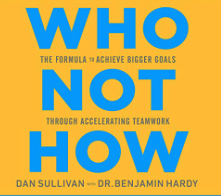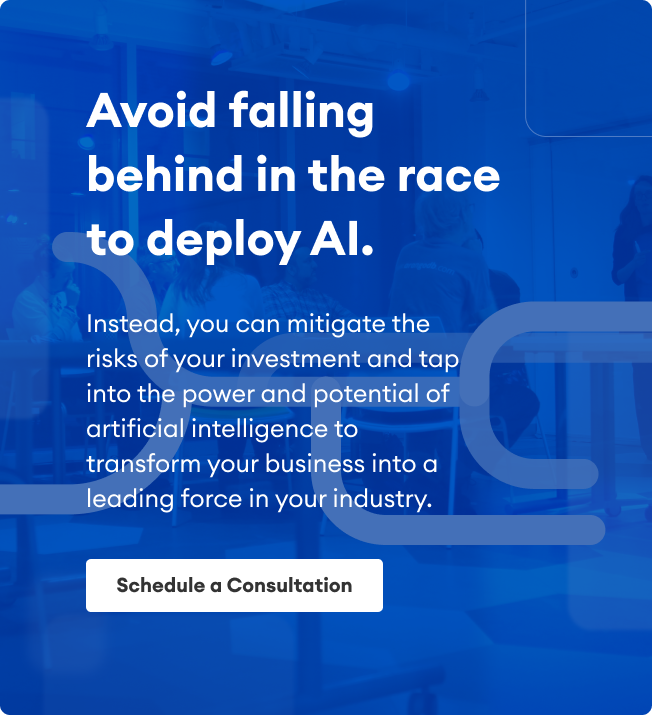Most leaders, and certainly most entrepreneurs, feel swamped at work. They’re tired, they’re stressed, and work that is supposed to be done, isn’t getting done. They feel that it’s just not fair, that for all the work they’re putting in, that they don’t get more time to spend with friends and family.
The question they constantly ask themselves is: How am I going to get all of this work done?
Before you dive into our blog article on how to answer this question, here are our Insights Up Front:
- Busy leaders ask themselves, “how will I get all this work done?”
- Smart leaders ask, “who can do this work for me?”
- The smartest leaders ask, “is there an AI that can do this work for me? And how can it make me and my team faster, better, cheaper, and happier at our jobs?”
If this is ringing some bells for you, you can book a free 30 minute Breakthrough Call for independent, vendor-agnostic advice on how to facilitate a conversation with your team about how AI can help. And you can keep reading to get more advice right now.
3 Steps to Shift Your AI Mindset
If you’re trying to figure out how to clone yourself just to get through the week, we get it. We’re entrepreneurs, and we’ve been there ourselves. But we’ve done the research, and we believe that is the wrong question.
Instead of asking “how” the work will get done, a better question to ask is “who” can help me achieve my goals? Crucially, the “who” does not need to be a person. The “who” can be artificial intelligence.
What do we mean? Let me explain, by helping you shift your mindset in 3 steps.
Step 1: Think Who, Not How
One of the leading sources of information for entrepreneurs is Dan Sullivan, at Strategic Coach.
He discovered that entrepreneurs are terrible at delegation. They know they’re supposed to delegate, but they’re hesitant. At least, they are when they view delegation as unloading their least desirable tasks to someone else. If you care about the people you’re working with, and you treat them the way you’d want to be treated, you’re naturally going to be hesitant about assigning them work you don’t like.
But what if your team members actually liked what you detested? What if they were great at the tasks at which you struggled? What if they didn’t want you to hold back on delegating, but wanted you to give even more of those tasks? That would be wonderful, right?
The argument that Dan makes in Who Not How is that we all have unique abilities. The trick is to figure out what you’re uniquely good at, and delegate all the rest to people with the appropriate unique ability. This is the key point: if you’re delegating work to them that is in their unique ability, they won’t resent work being delegated, they’ll love it. They’ll say, more please.

This brings us to the first mindset shift: stop worrying about “how” you will get all the work done, to asking “who” is uniquely able to do this work? That is the point of Who, Not How.
Take the example of writing Who, Not How. While Dan is listed as the primary author of the book, Dan didn’t write any of it. Instead, he shared the ideas with a colleague, Dr. Benjamin Hardy, and Hardy wrote it. Hardy, in other words, was the “who” to get the job done. With virtually no additional effort, Dan now has a best-selling book.
Many entrepreneurs struggle to get all their administrative work done. A service like Delegate Solutions is built on the idea of Who Not How. It’s virtual executive executive assistance model proactively removes busywork from their schedule, helping them to optimize their time, maximize their impact and realize their vision.
The benefits to making this switch are enormous. By finding the right “who” you can achieve bigger and more powerful results, without having to do all the work. You can even accomplish multiple goals at the same time. All of these “whos” can take your goals to places you never imagined.
Step 2: AI Could be Your Super “Who”
Alright, we’ve made the first step, and have seen that it can be liberating to switch from worrying about how something will be done, to who can do it.
Easier said than done, right? For all of this to work, there has to be a “Who” available, and finding talent is always one of the hardest jobs at any company.
Now we’d like to introduce a second shift in your mindset.
What if instead of automatically assuming that the Who was another person, you were open to the possibility that the Who could be an artificial intelligence or AI?
This shift may seem odd at first. After all, humans and computers are quite different.
But think about science fiction, with advanced robots. These robots could carry out some functions that a human could, right?
Well, artificial intelligence is a bit like that, except it is no longer science fiction.
Over the past 10 years, the capabilities of AI have expanded beyond belief. We say their capabilities are growing exponentially. For example, computing power has doubled about every 9 months. Since 2011, computers are approximately 300,000 times more powerful. At that rate, in 9 months, they will be 600,000 time more powerful than in 2011, and in a year and a half, they will be 1.2 million times more powerful than in 2011. And so on.
What does all this mean for our everyday lives and jobs?
It means that AI can be trained to carry out specific functions. What is even more remarkable is that the AI can learn while on the job, and get better over time.
You can teach an AI t to look, listen, read, write and integrate knowledge. In other words, instead of asking a person to do a job, you can ask an AI to do it instead.
Some examples will make clear how the AI can do some jobs even better than a human. They can be your “Super Who.”
- Paperwork. Today a significant amount of time is occupied by simply processing data in manual spreadsheets. Performing reconciliations, creating reports, and chasing approvals account for a major portion of professionals’ daily activities. AI Assistants can streamline repetitive processes. They can learn, mimic, and then execute rules-based business processes. Show your AI what to do, then let them do the work. It can interact with any application or system in much the same way people do—except that the AI can operate around the clock, nonstop, much faster and with 100% reliability and precision. Two of the leading vendors in this space are AutomationAnywhere and BluePrism.
- Sales team bots. Suppose that you have thousands of people visiting your website. Your sales team can’t follow-up with every single person, so they prioritize. But this means that some potential customers get little to no attention, and money is left on the table. An alternative approach is to use an AI Assistant to reach out to 100% of customers. AI Assistants can engage each lead soon as an inquiry is made and can respond in seconds. Prompt, personalized, and persistent engagement from an AI Assistant helps teams connect website visitors to information instantly, pre-qualify new leads quickly, and drive higher registration to your webinars and events. Top leads get passed off to the actual members of the sales team, who appreciate that they get the best leads without all the back-and-forth with customers on routine issues. One of the vendors in this space is Conversica.
- Forecast Revenue, Expenses and Cash Flow. Most companies try to predict future revenue by looking at a historical series of data (time series data). The underlying assumption is that the future is determined by the past. However, looking forward, demand for a particular colour of shirt may change with the seasons, store location and other factors such as price and web traffic. AI can use “machine learning” to combine historical date with these additional variables to build forecasts. This complex relationship is hard to determine on its own, but machine learning is ideally suited to recognize it. In fact, the AI can look at the data and see patterns in ways that humans just can’t do, which improves the quality of the forecast. Amazon’s Forecast is a leading vendor.
One thing to keep in mind is that right now these AI can do one narrow thing, and do it very well. The AI for the sales team can’t do the work of the AI for the forecasting team, and vice versa. We are still a ways away from having Hal from 2001 a Space Odyssey, or the Terminator show up.
Even still, imagine the impact that a small group of employees could have if they were supported by a combination of different AIs. Your team could focus on their unique abilities, and delegate work to an AI that worked 24 hours a day, and maybe could do things no human would ever be able to do.
Step 3: A Who to Find Your AI Who
Alright, we’ve seen that it makes sense to stop thinking about how work will get done, and think instead about who can do it.
We’ve also seen that the Who can be an AI.
The next question is, how to find an AI? Or rather, “who can find me an AI?”
This is the third shift in your mindset. With apologies to Dr Seuss, what you need is a Who to find your AI Who.
Navigating through the AI options is not easy. On the one hand, the potential of AI is enormous. It’s been said that by 2030 there will be two types of businesses: those that use AI and those that are bankrupt.
On the other hand, approximately 80% of AI projects fail to fulfill their promises because businesses are sold the wrong solutions. This leaves entrepreneurs feeling doubtful about any advice you might receive.
We know how hard it is to find unbiased guidance for artificial intelligence. Typically, you’ll be dealing with a vendor that has a vested interest in one solution.
That is where we come in.
We believe you deserve vendor-agnostic guidance that makes sure you’re matched to the right solutions for your environment. We protect your interests as your independent guide through this new frontier. We make sure you know what needs to happen and who’s qualified to help you so your journey begins with a clear path to success.
We bring both business leadership experience and technical expertise in AI to the table. This allows us to make sure you find the right solutions by serving as translators between your business goals and the technical requirements needed to fulfill them. Once your solutions are identified, we have access to a vast network of AI professionals and can find the right, trustworthy talent for any situation.
We typically follow a three step plan: assess your potential for AI, discover what will work in your environment with your data and infrastructure, and recommend the best fit solutions.
You can avoid falling behind in the race to deploy AI and mitigate the risks of your investment.
Tap into the power and potential of artificial intelligence to transform your business into a leading force in your industry by scheduling a no-charge Consultation today. We’ll help you find the right Who for you.


